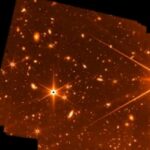
Micrometeoroids have impacted the James Webb Space Telescope (JWST), however NASA says to not fear. The house company reported that between May 23 and 25, the house telescope suffered an impression to one in every of its main mirror segments.
The extremely anticipated house telescope has been present process a six month journey of preparation earlier than it begins it main responsibility of gathering knowledge. JWST is getting nearer to changing into absolutely operational and is anticipated to begin sending again its first full-color pictures by July 12, 2022. Part of its historic journey, nonetheless, shall be enduring impacts from micrometeoroids.
NASA reported on June 8 that Webb suffered impacts by micrometeoroids, however these varieties of strikes have been to be anticipated. However, the facility of the strike that occurred in late May, the fifth recorded since its launch, was extra highly effective than operators had anticipated. It would require engineers to regulate the instrument to compensate for the sudden injury.
“After initial assessments, the team found the telescope is still performing at a level that exceeds all mission requirements despite a marginally detectable effect in the data. Thorough analysis and measurements are ongoing,” NASA reported in a latest weblog.
One of the challenges the groups at NASA will face is what they’ll do if one thing extra extreme occurs to Webb. The telescope is at the moment orbiting an excellent distance from Earth, roughly 1 million miles (1.6 million km) from our planet.
Engineers designed the house telescope to be extremely sturdy. It underwent a battery of testing to imitate the circumstances it would expertise within the huge depths of house. NASA says Webb is able to taking a lifetime of harm and stay operational.
“We always knew that Webb would have to weather the space environment, which includes harsh ultraviolet light and charged particles from the sun, cosmic rays from exotic sources in the galaxy, and occasional strikes by micrometeoroids within our solar system,” said Paul Geither, technical deputy challenge supervisor at NASA’s Goddard Space Flight Center. He added, “We designed and built Webb with performance margin, optical, thermal, electrical, mechanical, to ensure it can perform its ambitious science mission even after many years in space.”
The truth strikes of this nature have been anticipated, ground-based controllers are capable of considerably compensate for the injury. “Engineers have already performed a first such adjustment for the recently affected segment C3, and additional planned mirror adjustments will continue to fine tune this correction,” NASA remarked in its weblog put up. The company added that the steps could be repeated when wanted sooner or later as a part of the monitoring and upkeep of the house telescope all through its mission.
Top Image Credit: NASA









